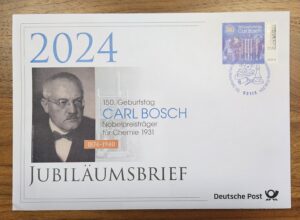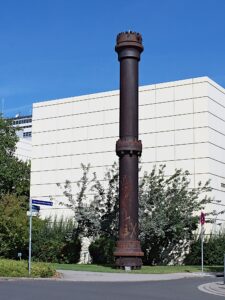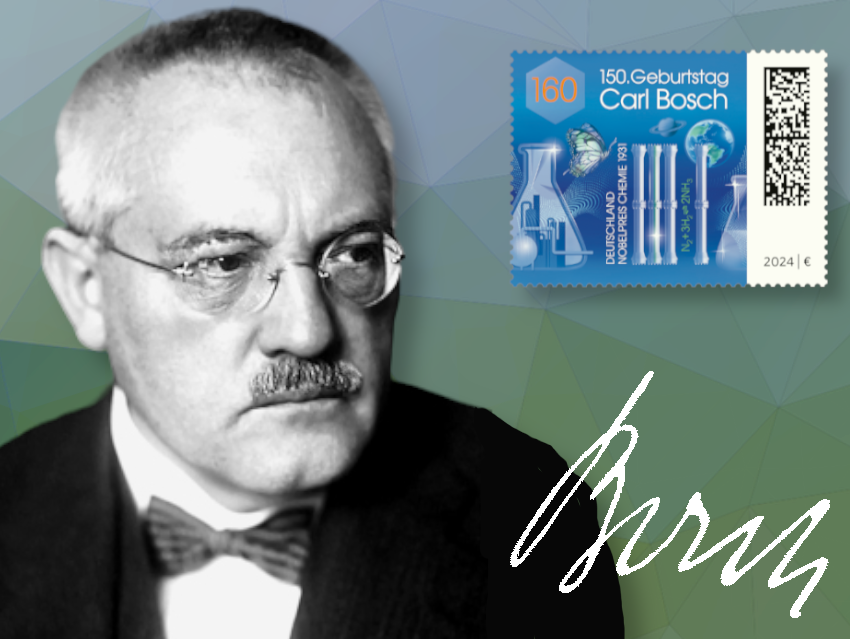Carl Bosch Stamp
Deutsche Post has issued a stamp and a commemorative letter to mark the 150th anniversary of the birth of Carl Bosch (1874–1940). The chemist and engineer Carl Bosch was one of the most influential industrialists of the 20th century. He was the nephew of the entrepreneur and inventor Robert Bosch, who founded the company Robert Bosch GmbH, commonly known as Bosch, in Stuttgart, Germany, in 1886.
The stamp was released on August 1, 2024, at the Carl Bosch Museum in Heidelberg. Opened in 1998, the museum is dedicated to the life and work of the chemist and Nobel Prize winner Carl Bosch. The building originally served as a residence for Bosch’s chauffeurs and as a garage for his cars. Carl Bosch lived in Villa Bosch, a few hundred meters from the garage. Today, Villa Bosch houses the Klaus Tschira Foundation.
The stamp shows ammonia reactors, the reaction of nitrogen and hydrogen to form ammonia, and a schematic representation of a chemical factory in an Erlenmeyer flask. In addition to chemistry and engineering, Carl Bosch was also interested in mineralogy, astronomy, botany, and collecting insects. Parts of these collections can be seen at the museum in Heidelberg, and symbols representing these interests are featured on the stamp.


Figure 1. Stamp and commemorative letter from Deutsche Post to mark the 150th anniversary of the birth of Carl Bosch (1874 – 1940).
Haber-Bosch Process
Carl Bosch was born in Cologne, Germany, on August 27, 1874. From 1894 to 1896, he studied mechanical engineering and metallurgy at the Technische Hochschule Charlottenburg (now Technical University of Berlin, Germany). He then studied chemistry in Leipzig, Germany, earning a doctorate in organic chemistry in 1898. In 1899, he joined Badische Anilin- und Soda-Fabrik (BASF) in Ludwigshafen, Germany, as a chemist.
In 1909, he began working on the industrial-scale implementation of the ammonia synthesis process developed by Fritz Haber. Fritz Haber was awarded the Nobel Prize for this in 1918. Through persistent development work, Bosch made the ammonia synthesis process ready for large-scale industrial application. The Haber-Bosch process made it possible to mass-produce ammonia, an essential raw material for the chemical industry. The economical access to ammonia allowed to produce niitrogen-based fertilizers at low cost. Carl Bosch thus made a major contribution to ensuring the nutrition of large parts of the world’s population.
On September 9, 1913, the first Haber-Bosch reactor went into operation at the Oppau ammonia plant. In the following years, ammonia production was systematically increased. At Bosch’s suggestion, BASF began construction of the Merseburg ammonia plant near Leuna in 1916.
In 1919, Bosch became a member of BASF’s Board of Executive Directors and its chairman.
In 1922, under Bosch’s leadership, BASF expanded the use of high-pressure catalytic processes, including artificial coal hydration.

Figure 2. On the grounds of the Karlsruhe Institute of Technology (KIT), Germany, is the ammonia reactor of the Badische Anilin- und Soda-Fabrik (BASF), built in 1921. (CC BY-SA 3.0)
I.G. Farben
With Carl Duisberg (1861–1935) of Bayer Leverkusen, he led the merger negotiations of the major German chemical companies (including BASF, Hoechst, Bayer, and Agfa) to form I.G. Farben. Bosch became chairman of I.G. Farben’s board of management in 1925 and chairman of its administrative and supervisory board in 1935. At the helm of the globally active I.G. Farben corporation, he not only influenced the German and European chemical industries, but also shaped international industrial development.
In 1931, Carl Bosch was awarded the Nobel Prize in Chemistry, together with Friedrich Bergius, for his contributions to the development of chemical high-pressure technology. In 1935, he became chairman of the supervisory board of I.G. Farben. In 1937, Bosch was elected President of the Kaiser Wilhelm Society for the Advancement of Science (now the Max Planck Society), succeeding Max Planck.
More Than a Great Chemist and Industrialist
In the 1930s, despite his great personal commitment, Carl Bosch was unable to prevent Jewish scientists from losing their positions and being persecuted. He is said to have warned Hitler that expelling Jewish scientists would set German Physics and Chemistry back a hundred years. The increasing persecution of his person by Nazi policies finally led to his retirement from public life.
The loss of his post at I.G. Farben in 1935, political developments in Germany, and at times excessive alcohol consumption caused Bosch to suffer from severe depression, and in 1939 he attempted suicide. Carl Bosch died on April 26, 1940 in Heidelberg.
Time and again, Carl Bosch acted as a patron and donor. In 1930, for example, he provided substantial financial support for the liberal Frankfurter Zeitung through the Imprimatur GmbH, and made possible the establishment of the Heidelberg Zoo.
Sources
[1] 75th Anniversary: Carl Bosch’s Death, ChemistryViews 2015.
[2] Carl Bosch Museum, Heidelberg, Germany (accessed August 21, 2024)
Also of Interest

Every day until December 24 we will unlock a new destination for your bucket list—join our chemistry Europe trip
 Commentary: Hamsterkauf
Commentary: Hamsterkauf
An Austrian stamp is printed on real toilet paper using an elaborate process

Nobel Laureate and co-inventor of the Haber-Bosch process (1874 – 1940)

Fritz Haber, who received the 1918 Nobel Prize in Chemistry for the synthesis of ammonia from its elements, died January 29, 1934





